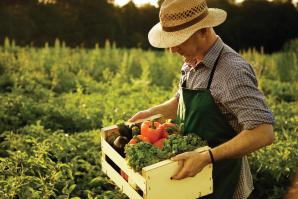It’s lunchtime at Fred T. Korematsu Elementary in Davis. A cafeteria monitor stands over the first, second and third graders, but she is only a scarecrow. One by one, the children obediently serve themselves broccoli, lettuce and individually wrapped kiwis from a salad bar. If they refuse two servings of produce, they know they will be denied fried chicken at the end of the line.
Outside, plastic wrappers are flying off string cheeses and kiwi cartons as kids furiously nosh apples and other hand-held foods. They shout across tables and contort their faces in displays of intense happiness or disgust while devouring their entrees.
They are, mostly, eating the broccoli.
An effort to get locally grown food down the gullets of school children is catching on across the Capital Region and the rest of the country. School districts in Yolo County are participating in Harvest of the Month, a state program that serves and educates students about one locally grown fruit or vegetable each month. In Sacramento, a new Edible Schoolyard project at Charter High School plans to serve teenagers food they grow themselves in a student-run garden. And in select pockets of California, from Redding to Riverside, school districts have begun embracing farm to school, a broadly defined program that delivers local produce into school cafeterias.
The trend has been propelled by 2010 federal legislation that reduced the maximum amount of calories a child can be served in the lunchroom and increased mandatory servings of fruit and vegetables. Advocates say farm to school programs educate young people about the economic importance of the state’s agricultural belt while opening distribution channels for small-scale farmers. The push is also directed at combating child obesity — more than one in three California kids are overweight, according to the state Center for Public Health Advocacy in Davis.
While farm to school receives enthusiastic support from child health and agricultural interests, many schools still have significant economic and social hurdles standing in their way. Anyone who has actually attempted to feed vegetables to a human child knows that kids often like broccoli about as much as a trip to the dentist.
There is also the problem of price. Major mechanized farming operations have far cheaper costs than smaller operations, making local distribution difficult to advance in the conventional food system. While the 2010 Healthy Hunger-Free Kids Act raised the quality of school lunch, it only provided an additional six cents per meal; the state and federal meal reimbursement is still about $3. Roughly two thirds of that is swallowed by overhead, and that’s whether the food is prepared on site or by a contracted private company. Meanwhile, buying locally sourced food can double the price of ingredients.
Farm to school is also challenged by the fact that small scale growers often don’t have the safety certifications needed to distribute to schools, and in some cases they don’t have the time or desire, school officials say. Some school districts receive government grants or help from citizen groups to afford local food or connect them to interested growers. Other districts simply ask their major food distributor to start procuring locally. Those requests return varying results.
“I think the [districts] that have the grant and community collaboration are far more effective. Many food service directors in smaller districts are also managers and cooks, so probably not (much local procurement). It takes time to investigate it and look for it,” says Suzanne Grass, nutrition director at Grass Valley School District and the Sacramento region president for the California School Nutrition Association, an advocacy group.
Despite the barriers, the food system is beginning to move toward local procurement, albeit on a small scale, according to a representative for FreshPoint, a distributor that serves produce to 60 school districts in Northern California.
“(FreshPoint) has all these clients that are demanding this, and it actually becomes a sales tool for us,” said the representative, who was not authorized to speak for attribution. “It’s really the customer demand that makes the market work. That’s what drives it.”
However, FreshPoint’s local procurement is still minor compared to the company’s overall volume. “The bulk of our business is in the conventional large farm that can send us pallets,” said the representative. FreshPoint, a subsidiary of global food giant Sysco, operates out of Turlock and delivers food grown in California, Arizona, Washington, Florida and parts of Central and South America.
Attempts to bring local food into schools has a storied history in the Sacramento region, and the movement has remained vulnerable to other changes in education and food policy. The National School Lunch Program began in 1946 after President Harry Truman declared child health a matter of national security. The president’s announcement was partly due to the fact that, for the first time ever, young men who had grown up during the depression were dismissed from the draft for undernourishment.
About half a century later, state schools chief Delaine Eastin announced a statewide initiative to put a garden in every school. The effort struggled under an education establishment in Sacramento that disliked the idea because it detracted from classroom time. Eastin was a longtime champion of serving kids fresh produce, and railed against the processed and canned food offerings in cafeterias across California. But her successor, Jack O’Connell, did not give school lunch reform the same priority. Interesting aside: O’Connell strongly dislikes vegetables, and once during a lunch with this reporter, the former State Superintendent of Public Instruction was observed removing the lettuce from his hamburger. It is unknown, however, if O’Connell’s culinary preferences had any link to his policy directives.
Despite mixed messages from the state, a grassroots effort around farm to school grew in the late 1990s. The first reports came from schools in Santa Monica and Malibu, which introduced salad bars into their cafeterias featuring ingredients from a local farmer’s market. Hearing the news, a group of about a dozen women in Davis set out to bring the same concept to their local schools.
After more than a decade of fits and starts, the Davis school meal program is considered a national model, with a salad bar at every school, plus garden-based education and field trips to farms. The program is paid for with the help of state grants, fundraising events and the recent renewal of a local parcel tax.
In Davis, about 30 percent of the school produce is grown within 300 miles, which may seem like a giant radius to classify as local or even regional, but program supporters say the idea is to teach kids about seasonal food while providing enough volume for them to notice. Much of that produce comes from Capay Organic, a grower that’s also the central distributor for the county’s Harvest of the Month program.
Thaddeus Barsotti, Capay’s co-CEO, claims to possess a “utopic view of how we could feed the world,” but he also considers himself a pragmatist. He says the Harvest program is an important first step, but he also sees far more potential than is currently being realized.
The schools participating in Harvest of the Month receive a limited supply of local produce because they purchase it off an inventory list of food grown for restaurants and farmers markets. In other words, the farms are not planting specifically for the schools, though they could in the future, says Barsotti. But if Capay were to dramatically increase their offerings to schools, it would likely increase prices for the school districts and create some level of unpredictability. Small-scale farming operations are more vulnerable to weather, and if a freeze destroyed a local harvest, the school’s crops would need to be outsourced. Some might argue that outsourcing would defeat the whole purpose of paying more to buy local. These challenges could conceivably be resolved, he says, but school representatives have not yet sat down for a serious discussion.
“The school cafeteria isn’t equipped with that type of knowledge and logistical management that lets them aggregate many local farms as suppliers, so they tend to want to find relationships with a few full-service distributors where they just sign the dotted line and it shows up like clockwork,” says Barsotti.
School cafeteria workers argue that they have far more pressing priorities than serving locally grown food. The primary challenge is in delivering nutritious meals to a wide swath of young people for a limited government reimbursement. They also have to please their customers — the kids eating the food and the parents paying for it.
Davis Joint Unified is located in a largely affluent community with many parents employed by a public university that prides itself as an agricultural powerhouse. Last year, city residents renewed a parcel tax that funds the school system, and a local nonprofit group handles marketing for the cafeteria program. The idea is to maximize exposure to more affluent parents who will see the district’s gourmet cuisine and sign up their children, because substantial funding for school lunch comes from paying parents, not government subsidies. The Davis lunch menu features culinary offerings such as teriyaki tofu, rice bowls and hamburgers served on whole-wheat buns.
About 15 miles northeast of Davis, Natomas Unified does not benefit from a parcel tax or a nonprofit promoter for their meal program. But the district does have 6,000 meals to serve each day to the student body, 75 percent of which come from low- income families that qualify for subsidized meals. The Natomas lunch menu contains nutritious offerings like Mediterranean and garden salads, but it also features chicken nuggets, nachos and hot dogs.
Food service operators in Natomas say their menu options are somewhat bound by what the kids are willing to eat. Many students regularly receive fast food at home and have developed an appetite for it. “If I tried to serve tofu teriyaki, my kids would say, ‘What the heck are you trying to serve me?’ You need to deal with your community,” says food services director Julie Dorman. The Natomas cafeteria staff tell stories of kids saying, “I’m going to eat all this lunch because I’m not going to eat again until tomorrow.” “So I’m going to give them something they will eat,” she says.
Since arriving last year, Dorman implemented a salad bar at every school site and still managed to bring the cafeteria from a $585,000 annual deficit to a $125,000 surplus, mostly by transitioning to on-site preparation from a privatized food service, she says. Dorman is optimistic that major school food providers will eventually respond to the growing demand for locally grown food, but until then, she is determined to balance fresh produce — regardless of where it is from — with food that kids actually eat.
“Cooking from scratch would be awesome in every school. Is it really doable? No. So I offer great fruits and vegetables. I’m still going to have a chicken nugget on the menu, a processed food item. I’m not going to get away from it. That’s what kids like. But I know if I can offer good fruits and vegetables, spend a little extra money on that, I’m doing the right thing.”
Recommended For You

Eat it Up
Why you should salivate over Sacramento’s farm-to-fork mantra
In October of last year, Sacramento Mayor Kevin Johnson declared Sacramento the “Farm-to-Fork Capital of America,” presenting the city with a long-term opportunity to build a distinct brand identity that could help the region attract and retain citizens, conventions, tourists and entrepreneurs. It’s especially valuable because a strong regional identity gives energy to the economic engines that make cities successful. Anyone needing proof can look directly to Austin, Texas.




